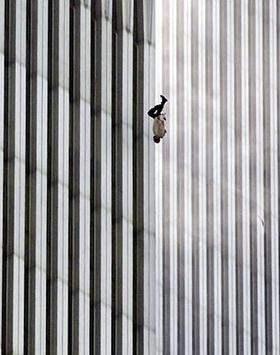1. Overview
Richard Drew, born on December 6, 1946, is a prominent Associated Press photojournalist renowned for capturing iconic moments in history. His work often focuses on the human element within significant events, making his photographs powerful and thought-provoking. Among his most recognized works is "The Falling Man", an image taken during the September 11 attacks that profoundly impacted public discourse. Drew was also one of the few press photographers present at the Robert F. Kennedy assassination, further cementing his legacy as a witness to pivotal historical moments.
2. Early life and background
Richard Drew was born on December 6, 1946. Details regarding his early life, family background, or educational experiences that might have influenced his career path into photojournalism are not available in the provided sources.
3. Career
Richard Drew's career as a photojournalist has been marked by his presence at and documentation of some of the late 20th and early 21st centuries' most significant events.
3.1. Photojournalism
As a photojournalist, Richard Drew has dedicated his career to capturing real-time events through his lens. His approach involves being on the ground during critical moments, aiming to document history as it unfolds. His work spans various assignments, reflecting the broad scope of a photojournalist's responsibilities in news reporting.
3.2. Associated Press
Richard Drew has served as a photojournalist for the Associated Press (AP), one of the world's largest and oldest news agencies. His tenure with the AP has placed him at the forefront of major news stories, where his photographs have been distributed globally, providing visual accounts of historical events to a wide audience. His role at the AP has allowed him to cover assignments that have become defining moments in his career.
4. Major Works and Covered Events
Richard Drew's portfolio includes several highly impactful photographic works, primarily stemming from his coverage of major historical events.
4.1. "The Falling Man"
One of Richard Drew's most iconic and controversial photographs is "The Falling Man", taken on September 11, 2001, during the September 11 attacks in New York City. The photograph captures an individual falling headfirst from the North Tower of the World Trade Center after it was struck by American Airlines Flight 11. The image, taken at approximately 9:41:15 AM, depicts a man, believed to be Jonathan Eric Briley, inverted and perfectly vertical against the backdrop of the collapsing tower.

"The Falling Man" quickly became a subject of intense public debate and ethical consideration due to its graphic nature and the sensitive context of the 9/11 tragedy. While some viewed it as a poignant representation of the desperation faced by those trapped in the towers, others found it too disturbing or disrespectful to the victim. The photograph is notable for its stark portrayal of a human figure in an act of desperation, isolated from the chaos around him, almost appearing serene in his descent. Its publication sparked discussions about the role of photojournalism in depicting human suffering and death, and the balance between informing the public and respecting individual privacy and dignity. The photograph was notably the subject of a September 2003 article by Tom Junod in [http://www.esquire.com/features/articles/2003/030903_mfe_falling_1.html Esquire] magazine.
4.2. Robert F. Kennedy assassination
Richard Drew was one of only four press photographers present at the Robert F. Kennedy assassination. On June 5, 1968, Senator Robert F. Kennedy was shot shortly after claiming victory in the California presidential primary at the Ambassador Hotel in Los Angeles. Drew's presence at this critical moment allowed him to document the immediate aftermath of the shooting, capturing a significant historical event that profoundly impacted American politics and society. His photographs from this event provide a rare and intimate glimpse into a moment of national tragedy, showcasing his ability to be at the right place at the right time to record history.
5. Evaluation and Legacy
Richard Drew's photographic work holds significant historical, social, and cultural importance, particularly his images from the September 11 attacks and the Robert F. Kennedy assassination. His photographs have contributed to the collective memory of these events and have sparked important discussions about the ethics and impact of photojournalism.
5.1. "The Falling Man" documentary
The photograph "The Falling Man" became the subject of a British documentary film titled 9/11: The Falling Man. The documentary premiered on the Discovery Times channel on September 10, 2007, nearly six years after the attacks. The film delves into the story behind the photograph, exploring the identity of the man depicted, the ethical dilemmas faced by photojournalists in publishing such images, and the public's varied reactions to the photograph. It examines the image's role in shaping the narrative of 9/11 and its lasting impact on those who witnessed or encountered it. The documentary further solidified the photograph's place as a powerful, albeit controversial, symbol of the September 11 attacks.
5.2. Impact of Photography
Richard Drew's photography, particularly "The Falling Man" and his coverage of the Robert F. Kennedy assassination, has had a profound impact on public consciousness and historical memory. His images serve as powerful visual records of pivotal moments, allowing future generations to understand the human experience during times of crisis and change. "The Falling Man" specifically highlighted the ethical complexities inherent in photojournalism, prompting widespread debate about the boundaries of news photography and the responsibility of the press. His work underscores the unique ability of a single photograph to encapsulate a vast narrative, evoke strong emotions, and contribute significantly to the historical record, influencing how society remembers and interprets critical events. His career and the impact of his work have been subjects of various media coverages, including an interview with [http://transcripts.cnn.com/TRANSCRIPTS/0110/11/ltm.06.html CNN] and an article by Peter Howe in [http://www.digitaljournalist.org/issue0110/drew.htm The Digital Journalist].